Invasive Plant
Species Profiles
 Spotted Knapweed: (Centaura stoebe) with its ability to spread in dry, sandy areas is an invasive seen in increasing numbers at Sand Point and alongside roads. Manual control at Sand Point has been done by KBIC youth crews with Superior Watershed Partnership and Ojibwa Community College volunteers. Plants are being dug up and disposed of and 2011 plans are to begin replacing with native plants and seed.
Spotted Knapweed: (Centaura stoebe) with its ability to spread in dry, sandy areas is an invasive seen in increasing numbers at Sand Point and alongside roads. Manual control at Sand Point has been done by KBIC youth crews with Superior Watershed Partnership and Ojibwa Community College volunteers. Plants are being dug up and disposed of and 2011 plans are to begin replacing with native plants and seed.
 Purple Loosestrife: (Lythrum salicaria) is a perennial that spreads rapidly in wetland ecosystems, degrading the quality of the wetland. KBIC has identified purple loosestrife in several locations on the L'Anse Indian Reservation. KBIC decided to use biological control, Galerucella beetles, at three areas. KBIC conducts annual monitoring and control of purple loosestrife within reservation boundaries.
Purple Loosestrife: (Lythrum salicaria) is a perennial that spreads rapidly in wetland ecosystems, degrading the quality of the wetland. KBIC has identified purple loosestrife in several locations on the L'Anse Indian Reservation. KBIC decided to use biological control, Galerucella beetles, at three areas. KBIC conducts annual monitoring and control of purple loosestrife within reservation boundaries.
 Japanese Barberry: (Berberis thunbergii) is native to Japan and was first introduced to the U.S. in the late 1800’s. It is found in a variety of habitats and as an ornamental. Japanese barberry has been noted during forestry work in several areas on the reservation. Large quantities are concentrated over multiple ownership lands near the tribal walleye pond property connected to the L’Anse school property.
Japanese Barberry: (Berberis thunbergii) is native to Japan and was first introduced to the U.S. in the late 1800’s. It is found in a variety of habitats and as an ornamental. Japanese barberry has been noted during forestry work in several areas on the reservation. Large quantities are concentrated over multiple ownership lands near the tribal walleye pond property connected to the L’Anse school property.
 Eurasian Watermilfoil: (Myriophyllum spicatum) is a submerged aquatic plant native to Europe, Asian, and northern Africa that has been known in North American since the 1940’s. It was first identified in Lake Superior in 2006. Eurasian watermilfoil grows rapidly in the spring and out competes our native plants for sunlight and space. An as-sessment of watermilfoil at Sand Point has taken place. No active control at this time.
Eurasian Watermilfoil: (Myriophyllum spicatum) is a submerged aquatic plant native to Europe, Asian, and northern Africa that has been known in North American since the 1940’s. It was first identified in Lake Superior in 2006. Eurasian watermilfoil grows rapidly in the spring and out competes our native plants for sunlight and space. An as-sessment of watermilfoil at Sand Point has taken place. No active control at this time.
 Exotic Honeysuckle: Several species of exotic honeysuckle (Lonicera spp.) have been introduced to the U.S. from Asia. Honeysuckle is a perennial vine that can quickly crowd out native plant species. At least one species of exotic honeysuckle has been identified on the reservation. Recommended control methods include removal of seedlings or small plants, herbicide application, and burning.
Exotic Honeysuckle: Several species of exotic honeysuckle (Lonicera spp.) have been introduced to the U.S. from Asia. Honeysuckle is a perennial vine that can quickly crowd out native plant species. At least one species of exotic honeysuckle has been identified on the reservation. Recommended control methods include removal of seedlings or small plants, herbicide application, and burning.
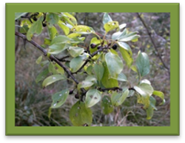 Buckthorn spp.: Common buckthorn (Rhamnus cathartica) and glossy buckthorn (Rhamnus frangula) are tall shrubs native to Eurasia. Buckthorn is found in a variety of habitats. They grow quickly and crowd out native plants. Recommended control methods include burning, girdling, and use of herbicides (or some combination of several methods).
Buckthorn spp.: Common buckthorn (Rhamnus cathartica) and glossy buckthorn (Rhamnus frangula) are tall shrubs native to Eurasia. Buckthorn is found in a variety of habitats. They grow quickly and crowd out native plants. Recommended control methods include burning, girdling, and use of herbicides (or some combination of several methods).
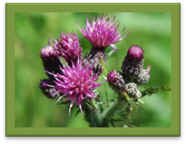 Marsh Thistle: (Cirsium palustre) is native to Europe and is an aggressive colonizer in a variety of habitats from wet areas to agricultural fields. Plants can grow over 6ft tall and are spiny with whitish hairs. Recommended control methods include hand pulling, mowing, herbicides, and the weevil Rhinocyllus conicus.
Marsh Thistle: (Cirsium palustre) is native to Europe and is an aggressive colonizer in a variety of habitats from wet areas to agricultural fields. Plants can grow over 6ft tall and are spiny with whitish hairs. Recommended control methods include hand pulling, mowing, herbicides, and the weevil Rhinocyllus conicus.
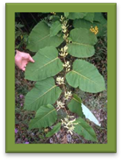 Giant Knotweed: (Polygonum sacha-linense) is an herbaceous perennial that can grow up to 12ft tall. It is native to Japan and was introduced as an ornamental and for erosion and forage control. This plant grows in various sites including. Dense stands quickly form and choke out native vegetation and clog small waterways. Recommended control methods are the same as those for exotic honeysuckle.
Giant Knotweed: (Polygonum sacha-linense) is an herbaceous perennial that can grow up to 12ft tall. It is native to Japan and was introduced as an ornamental and for erosion and forage control. This plant grows in various sites including. Dense stands quickly form and choke out native vegetation and clog small waterways. Recommended control methods are the same as those for exotic honeysuckle.
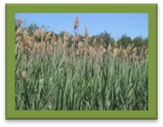 Common Reed: (Phragmites australis) is a perennial wetland grass native to Europe. Phragmites grows in dense stands, crowding out native species and causes other disturbances and hazards. Treatments include herbicide application followed by mechanical removal.
Common Reed: (Phragmites australis) is a perennial wetland grass native to Europe. Phragmites grows in dense stands, crowding out native species and causes other disturbances and hazards. Treatments include herbicide application followed by mechanical removal.
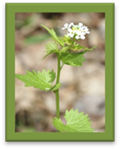 Garlic Mustard: (Alliaria petiolata) is na-tive to Europe and was introduced to the U.S. in the 1800’s. Garlic mustard is found in upland forests, roadsides, trail edges, and disturbed areas. It prefers shady, mesic areas with alkaline soils (but may be found in other conditions).
Garlic Mustard: (Alliaria petiolata) is na-tive to Europe and was introduced to the U.S. in the 1800’s. Garlic mustard is found in upland forests, roadsides, trail edges, and disturbed areas. It prefers shady, mesic areas with alkaline soils (but may be found in other conditions).
